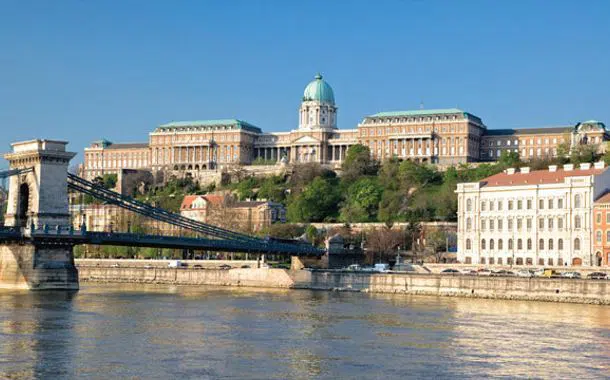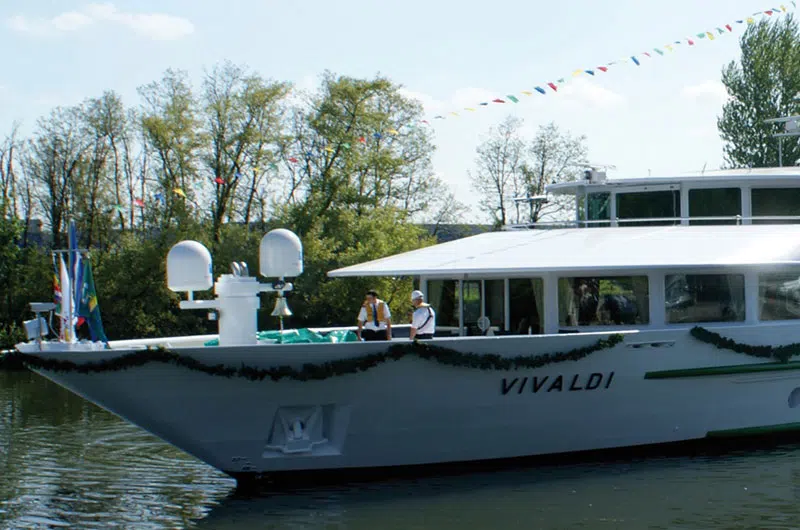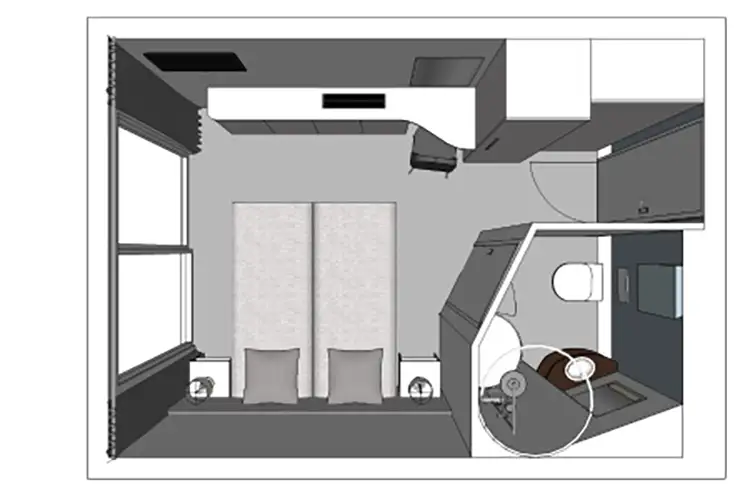CroisiEurope Danube: 11 nights from Vienna with Ms Vivaldi
Aug 7, 2025
Austria, Slovakia, Hungary, Serbia, Bulgaria, Romania
Cruise itinerary
Departure Port: Vienna ➞
Landing: Oltenita
-
Thursday, August 7, 2025 - 4:00 PMVienna
-
Friday, August 8, 2025 not found - not foundBratislava
-
Saturday, August 9, 2025 not found - not foundBudapest
-
Sunday, August 10, 2025 not found - not foundNovi Sad
-
Monday, August 11, 2025 not found - not foundBelgrade
-
Tuesday, August 12, 2025 not found - not foundBelgrade
-
Thursday, August 14, 2025 not found - not foundRuse
-
Friday, August 15, 2025 not found - not foundTulcea
-
Saturday, August 16, 2025 not found - not foundTulcea
-
Sunday, August 17, 2025 not found - not foundFetești
-
Monday, August 18, 2025 6:00 AMOltenita
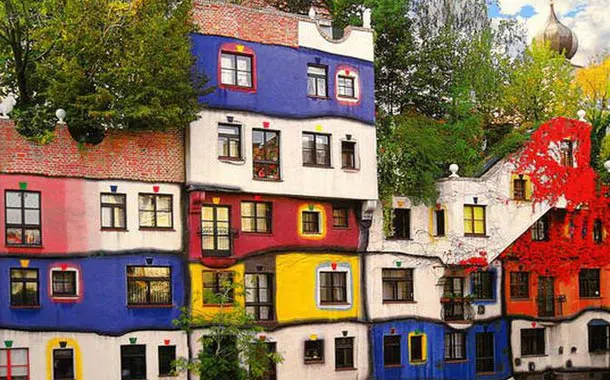
Vienna
Imperial River Journeys from Vienna!Embark on an enchanting river cruise from Vienna, Austria's imperial capital, and a city of unparalleled artistic and musical heritage. Situated on the Danube River, Vienna offers a magnificent departure point for exploring the scenic beauty and historical cities along this legendary waterway. Immerse yourself in its grand palaces, world-class museums, and vibrant café culture before setting sail on a journey promising picturesque landscapes and profound cultural insights.
Historical Charms of ViennaVienna, the capital of Austria, is steeped in history and culture, serving as a center for music, art, and intellectual pursuits for centuries. From the grandeur of the Habsburg Empire to the artistic legacy of Mozart and Beethoven, Vienna's past is a tapestry of architectural marvels and creative brilliance. The city's historic landmarks like Schönbrunn Palace and St. Stephen's Cathedral offer a glimpse into its illustrious past.
Pleasant Climate in ViennaVienna enjoys a temperate continental climate with warm summers and cold winters, creating distinct seasonal experiences for visitors. Summer months are ideal for exploring parks and gardens, attending outdoor concerts, and savoring al fresco dining along the Danube River. Winter transforms Vienna into a magical wonderland with Christmas markets, ice skating rinks, and cozy coffee houses offering warmth and charm.
Top Attractions and Places to Visit in ViennaVienna is a treasure trove of cultural attractions that cater to all interests. Explore the opulent Hofburg Palace, home to the Habsburgs, or wander through the Belvedere Palace to admire Klimt's "The Kiss." Stroll along the elegant Ringstrasse boulevard to see iconic buildings like the Vienna State Opera and Parliament. Don't miss a visit to the Naschmarkt for culinary delights and unique finds.
Local Cuisine: Authentic Flavors of ViennaViennese cuisine is a delightful blend of traditional dishes and international influences, showcasing flavors that please every palate. Indulge in Wiener Schnitzel, a breaded veal or pork cutlet, paired with potato salad or cranberry sauce. Savor Sachertorte, a decadent chocolate cake invented in Vienna, along with Apfelstrudel (apple strudel) and Melange coffee. Explore local markets for artisanal cheeses, sausages, and pastries.
Embark on an Unforgettable Cruise from ViennaTo elevate your Vienna experience, consider booking a river cruise departing from this enchanting city along the Danube River. River cruises from Vienna offer picturesque views of vineyards, castles, and charming villages along the riverbanks. Immerse yourself in the beauty of the Wachau Valley or cruise to Budapest or Bratislava for a multi-country adventure. Booking a cruise from Vienna promises unforgettable moments on Europe's iconic waterways.
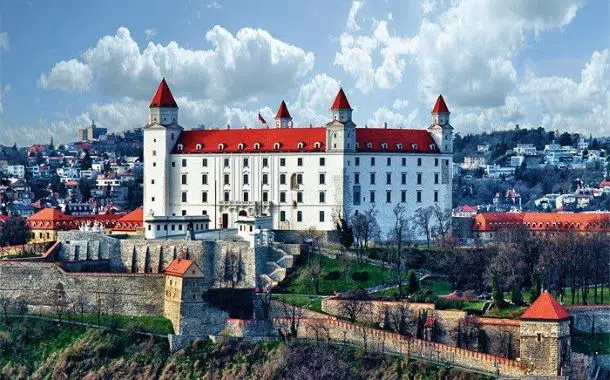
Bratislava
Ubicada a 60 km a nord-est di Vienna e nell'estremo sud-ovest della Slovacchia, di cui è la capitale, Bratislava si trova al confine con l'Austria, l'Ungheria e la Repubblica Ceca. Questa città di 500.000 abitanti, si trova nel centro geografico dell'Europa, con forte influenze slovacche, ma anche tedesche, ungheresi ed ebraiche, questo mix di popolazioni renderanno il vostro soggiorno davvero sorprendente. Il suo lato provinciale emana un certo fascino e la vita notturna attira nottambuli da tutta Europa. Il suo centro storico barocco, i suoi tesori di arte gotica e i vecchi locali rannicchiati intorno al suo castello, dominano il Danubio. Un luogo ideale per rilassanti passeggiate a piedi, sono i grandi parchi alberati. In questo borgo troverete di tutto, esclusive boutique, catene di negozi, mercatini, tutto il necessario per soddisfare le vostre esigenze. Il mercato più popolare lo troverete sulla strada di Mileticova; a prezzi molto convenienti e di qualità. Da Bratislava, si può facilmente arrivare a Vienna e Moravia, con la possibilità di visitare il castello di Devin, luogo tradizionale per gli abitanti della capitale slovacca. Alcuni dei monumenti più importanti di questo luogo sono: Il castello di Bratislava che domina la città, la cattedrale gotica di San-Martino, la Porta del Michael, il palazzo barocco di Grassalkovitch e il Municipio, residenza del Presidente della Repubblica slovacca. Lo Zoo locale, vicino al centro della città e facilmente raggiungibile con i mezzi pubblici, include un parco dei dinosauri su tre ettari, permettendo di rivivere l'Era Mesozoica attraverso la riproduzione di 27 specie di rettili preistorici e un parco giochi paleontologico per bambini. Il clima è continentale con inverni rigidi, il mese più freddo è a gennaio. Il periodo migliore per visitare è tra maggio a settembre, ma il l'afflusso turistico più alto avviene a luglio e agosto. Una buona alternativa, se non vi intimoriscono le temperature fredde, nel periodo tra ottobre e aprile, il paesaggio dona altrettanto fascino.
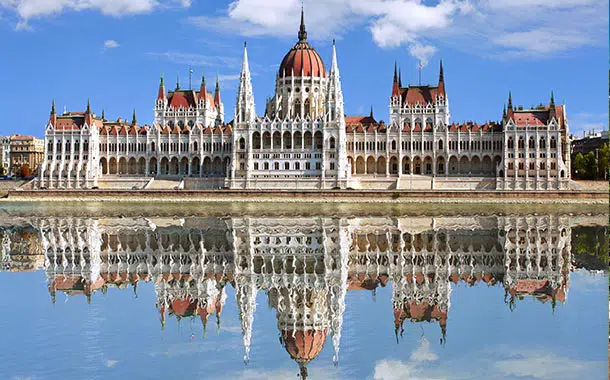
Budapest
The history of Budapest
The capital of Hungary, Budapest, is a crossroads of history and culture and the ancient charm combines with modern dynamism. Born from the union of the cities of Buda, Pest and Óbuda in 1873, Budapest has experienced Roman, Ottoman and Habsburg dominations, which have left a rich and varied legacy. Strolling through its streets, you can admire the Parliament, Buda Castle and Matthias Church.
Budapest's climate
Budapest has a continental climate, with cold winters and hot summers. The best season to visit the city is undoubtedly sping or early autumn, when the mild climate and sunny days offer the ideal setting for exploring the city on foot, discovering every hidden corners and its magnificent parks in bloom.
Attractions and places to visit
Crossed by the majestic Danube River, Budapest is famous for its thermal baths, its historic monuments and breathtaking views. Not to be missed are the Parliament, one of the oldest legislative buildings in Europe, Buda Castle, from which there are priceless views of the city, and the Chain Bridge, a symbol of unity between Buda and Pest. For a relaxing break, the Széchenyi Spa offers outdoor thermal pools, even in winter.
Local cuisine and typical products
Hungharian cuisine is a culinary adventure worth exploring. Thanks to dishes such as goulash, pörkölt and the delicious crepes called palacsinta you will discover intense falvours rich in history. You can taste them with a glass of Tokaji, Hungary's world-famous sweet wine.
Conclusion: an unforgettable holiday
Embarking on a cruise from Budapest offers a unique opportunity to start your journey by exploring a city rich in history, culture and natural beauty, before sailing across the waters of the Danube to fascinating new destinations. Budapest is not just a stopover, but a starting point for an unforgettable experience that will enrich your spirit and your heart.
The city is a mix of the French and Japanese cultures. For many years, it was a French territory, and the buildings are made in the French style. Later, the city was the first town for the trade with Japan and Korea, with its strategic position, it made a lot of merchants settle there. Some of the best attractions are the Hama-Rikyu Gardens and the Imperial Palace East Garden.
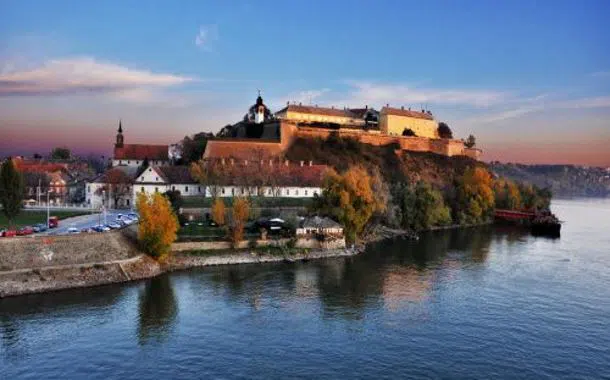
Novi Sad
Novi Sad is the administrative center of the autonomous province of Vojvodina. In the territory of Novi Sad, where human settlements dating back to prehistoric times were found. Between 1692 and 1780, during the Austro-Hungarian reign, the Petrovaradin fortress was built on the right bank of the Danube, one of the most famous fortified sites in Europe. The city of Novi Sad was built by the skilled hands of merchants and artisans, soldiers and bakers, butchers and other operators, who were registered as the founders of the city. The place is popular for its cultural mix. Its remote and recent past demonstrates the respected universal human values that lead to the culture of the inhabitants of this city. Knowledge, work, pacifism, tolerance and moderation, consider it the fundamental basis for progress. Thanks to this, the area is a unique environment that is characterized by its openness, hospitality and multilingualism. Its inhabitants, about 300,000, draw their energy from the Danube, which has shaped their temperament and the contours of this country. Also known for its festivals and cultural events such as: the Sterija Theater, Children's Games, Music Festival, International Alternative-Infantile Theater Festival, TID Regatta on the Agricultural Fair, International Fair of hunting, fishing, sports, tourism and nautical, without forgetting the largest music festival in South-Eastern Europe. Near Novi Sad there is the "Gora Fruska" a fantastic National Park and habitat for many animal species.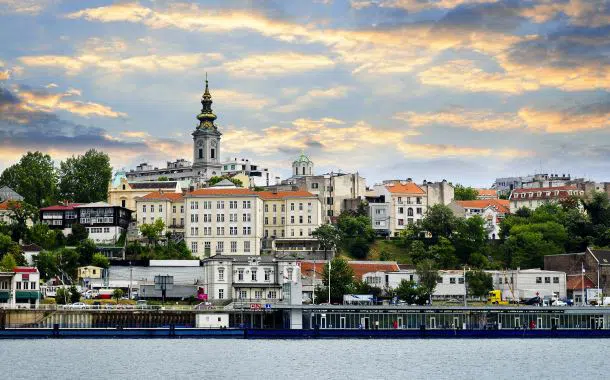
Belgrade
Discover Europe from the Heart of Belgrade!Embark on a captivating river cruise from the historic city of Belgrade, where the Sava meets the Danube. This vibrant capital offers a unique blend of ancient history and modern charm, providing an exceptional starting point for exploring Central and Eastern Europe's waterways. Sail through picturesque landscapes and discover cultural treasures, promising a journey of profound historical insight and serene riverine beauty.
Located in the center-north of Serbia and crossed by the Danube, Belgrade is the capital of the country and one of the oldest cities in Europe. Its turbulent history is reflected in its architecture, culture, and traditions. The city is home to numerous historic and monumental buildings. The best known are the National Museum, the Temple of Saint Sava, the monument to the unknown hero on Mount Aval, the old palace and the streets of Prince Michael and the thermal city of Jošanička Banja. Don't miss the fortress built on a rocky spur in the Kalemegdan park, at the intersection of the Sava and Danube, which combines Celtic, Roman, Slavic, Turkish, and Austrian architectures. The "white city" recommended for the splendor of its architecture and the unique mix of Western, Eastern, and Mediterranean influences. Belgrade is a city considered very youthful. More than 40% of the population are between 15 and 44 years old, all of whom are open and ready to have fun. The city loves to talk about the spirit of the city and is always available to provide information on everything there is to know, especially about good food, wine, and music. The inhabitants of Belgrade, like all sorts of things, love to be always on the move and, not surprisingly, the streets, sidewalks, bars, and restaurants are often crowded. On August 12th the Belgrade Beer Fest is celebrated, a very popular festival that attracts around half a million people every year, lasting 5 days.

Belgrade
Discover Europe from the Heart of Belgrade!Embark on a captivating river cruise from the historic city of Belgrade, where the Sava meets the Danube. This vibrant capital offers a unique blend of ancient history and modern charm, providing an exceptional starting point for exploring Central and Eastern Europe's waterways. Sail through picturesque landscapes and discover cultural treasures, promising a journey of profound historical insight and serene riverine beauty.
Located in the center-north of Serbia and crossed by the Danube, Belgrade is the capital of the country and one of the oldest cities in Europe. Its turbulent history is reflected in its architecture, culture, and traditions. The city is home to numerous historic and monumental buildings. The best known are the National Museum, the Temple of Saint Sava, the monument to the unknown hero on Mount Aval, the old palace and the streets of Prince Michael and the thermal city of Jošanička Banja. Don't miss the fortress built on a rocky spur in the Kalemegdan park, at the intersection of the Sava and Danube, which combines Celtic, Roman, Slavic, Turkish, and Austrian architectures. The "white city" recommended for the splendor of its architecture and the unique mix of Western, Eastern, and Mediterranean influences. Belgrade is a city considered very youthful. More than 40% of the population are between 15 and 44 years old, all of whom are open and ready to have fun. The city loves to talk about the spirit of the city and is always available to provide information on everything there is to know, especially about good food, wine, and music. The inhabitants of Belgrade, like all sorts of things, love to be always on the move and, not surprisingly, the streets, sidewalks, bars, and restaurants are often crowded. On August 12th the Belgrade Beer Fest is celebrated, a very popular festival that attracts around half a million people every year, lasting 5 days.
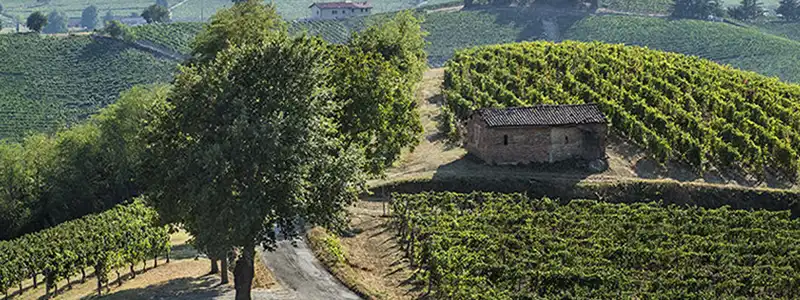
Ruse
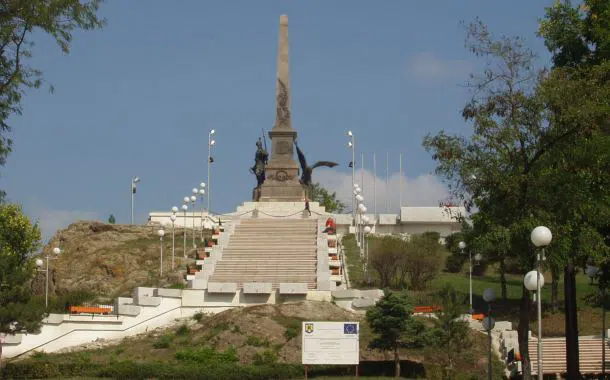
Tulcea
The city of Tulcea is located in the north-east of the province of Dobrogea, in the east of Romania, near the Black Sea, in Eastern Europe. It first appeared in official documents in the 16th century, when its territory was already under Ottoman rule. But only in 1878, at the end of the Russo-Turkish conflict, will it be donated to Romania. The geographical position, the history, and the economy of the country have attracted many foreign populations so that Tulcea has become a cosmopolitan city. From a tourist point of view, it is considered the gateway to the Delta. Most of the routes are made in this city, where it is subsequently divided into three main branches of the Danube Delta: the Chilia branch (north), in the Sf Gheorghe (south) and the Sulina branch (in the center). This activity allows us to provide transport services for tourists, but much remains to be done. Tulcea, however, is not just a gateway to the Delta, the place also has its tourist attractions, its main sites are the Ecotourism Museum, the Ethnographic Museum of Popular Art, and the ancient city of Aegyssus.

Tulcea
The city of Tulcea is located in the north-east of the province of Dobrogea, in the east of Romania, near the Black Sea, in Eastern Europe. It first appeared in official documents in the 16th century, when its territory was already under Ottoman rule. But only in 1878, at the end of the Russo-Turkish conflict, will it be donated to Romania. The geographical position, the history, and the economy of the country have attracted many foreign populations so that Tulcea has become a cosmopolitan city. From a tourist point of view, it is considered the gateway to the Delta. Most of the routes are made in this city, where it is subsequently divided into three main branches of the Danube Delta: the Chilia branch (north), in the Sf Gheorghe (south) and the Sulina branch (in the center). This activity allows us to provide transport services for tourists, but much remains to be done. Tulcea, however, is not just a gateway to the Delta, the place also has its tourist attractions, its main sites are the Ecotourism Museum, the Ethnographic Museum of Popular Art, and the ancient city of Aegyssus.
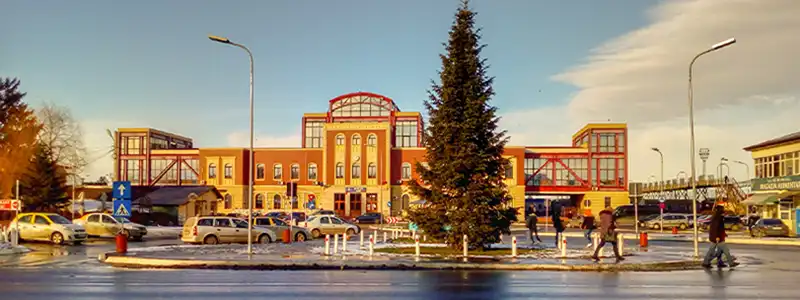
Fetești
